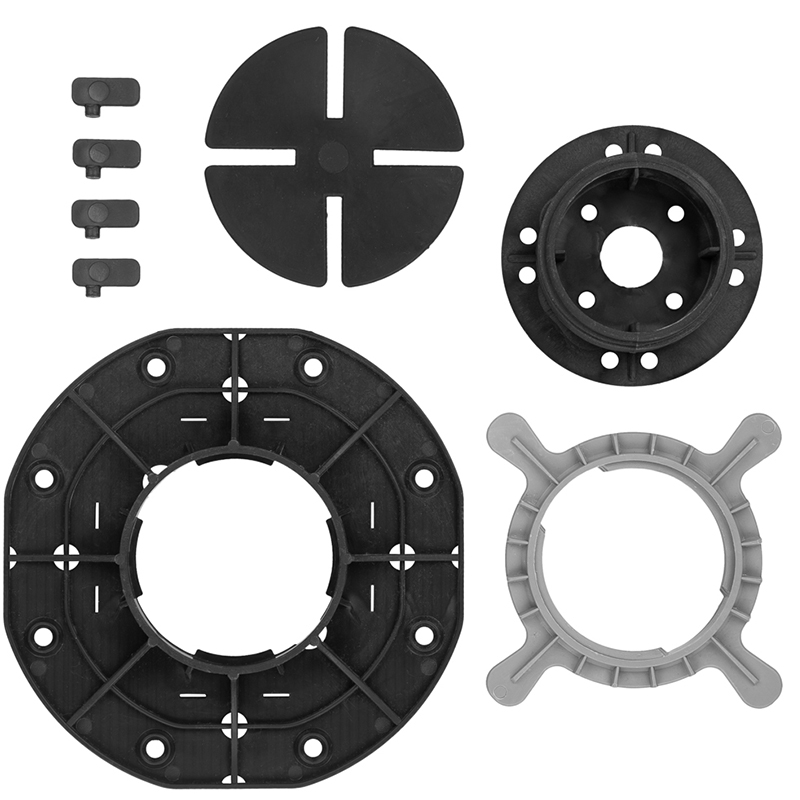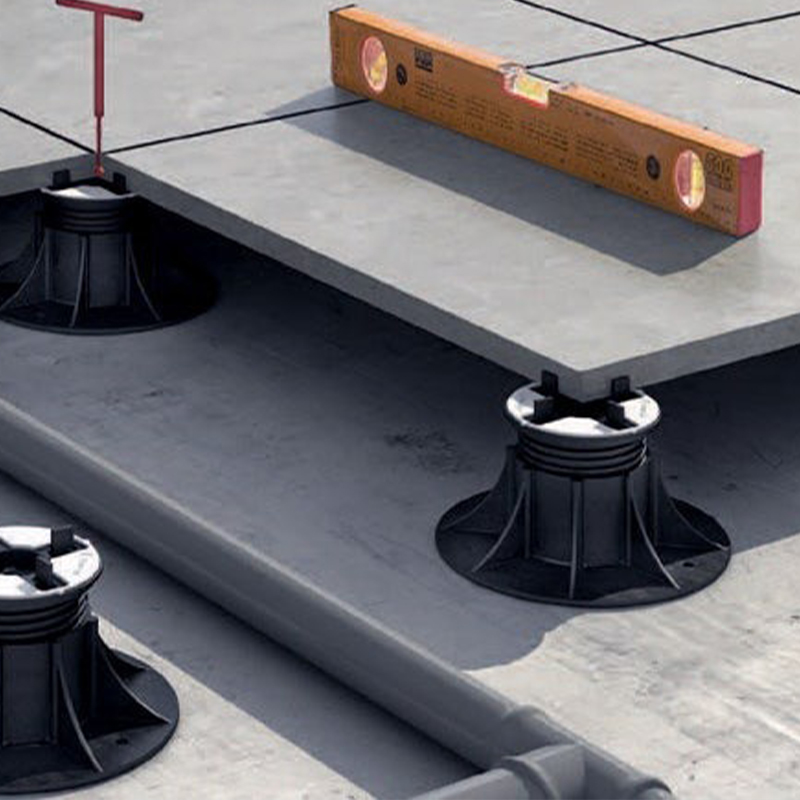Tile Pedestal System for Laying Tiles and Slabs
Tile Pedestal System for Laying Tiles and Slabs
Introduction
Laying a brand new porcelain tile patio or paving slab deck needn’t be back-breaking work. Adjustable system for tiles (or pedestals for paving slabs) allows you to lay tiles on almost any surface with ease.
By raising your outdoor tiles off the ground, adjustable-height tile pedestal systems allow for superior drainage, whilst creating a crawl space should you need one.

Especially handy for building a sundeck on your roof, a terrace on uneven surfaces, or a patio on concrete, our pedestal system for tiles offers total flexibility and freedom over exterior design and Irish home improvement.
Read to the end of this short article, and you’ll learn exactly what adjustable pedestals for tiles and decking are, their pros and cons, and how to install them safely and securely by yourself.
What are paving pedestals?
The pedestal systems we stock here in Tile Merchant Ireland are small, sturdy support systems designed to bear the full load of 20mm outdoor porcelain tiles, furniture, and people.
They may look small, but these wee things are cleverly crafted to spread up to 400kg of weight each evenly throughout their structure.
Our porcelain tile pedestals comprise a large flat base plate, the central screw pillar and screw ring – which together give the whole tile pedestal system its height – and the tile pedestal cap itself.

We also recommend complementing this setup with a 1mm rubber shim which sits between the pedestal and tile, protecting both from wear and tear.
Rubber joints are inserted into the spacers on the top of the pedestal cap, creating a cross-shape so that the corners of up to four porcelain outdoor tiles can be supported by just one pedestal.
The joints are about 2.2mm wide, creating a groutless gap between each tile of this width to allow rainwater to pass right through and drain away naturally beneath.
Laid out in a grid structure, these pedestals form a “suspended system” of tile support, requiring no mechanical fixings nor foundation prep whatsoever.
All that’s needed to hold the whole structure in place is the weight of the paving slabs or tiles – a simple yet effective trick of engineering, a little like the keystone in an archway.


The pros and cons of a pedestal system for tiles
Pros of tile pedestal system
● Cost effective: When you see the price of our paving pedestals, you might be surprised! Highly affordable, an outdoor porcelain tile pedestal system is more cost-effective than traditional installation because you don’t need to buy kilos and kilos of substrate, sand and cement, nor pay local contractors to install your new terrace for you.
● Easy installation: Laying a patio, deck or terrace of porcelain tiles doesn’t get easier than with an adjustable-height pedestal system. Minimal prep, minimal effort, maximum reward.
● Adjustable height: The screw ring positioned above the baseplate is ergonomically designed so that you can quickly and easily adjust the height of individual pedestals at any time. This gives you complete and continuous control over the level of your new tiled area for as long as it’s there.
● Superior drainage: Patio and terrace drainage can cause real problems – like mould and algae, or worse: flooding – especially on build sites like rooftops. The 2mm spacers, or joints, of our decking pedestals provide an effective solution to this issue.
● Design flexibility: Whether you’re indecisive or just like to freshen things up a bit every once in a while, because tile pedestals can be adjusted and moved at any time, they offer much greater flexibility over your Irish exterior design than traditional tile installation would.
● Engineered strength: Your biggest concern when it comes to installing any suspended system for outdoor porcelain tiles should rightly be strength and weight dispersion. Thankfully, however, you’re completely covered with an adjustable-height tile pedestal system. Holding up to 400kg per unit, and treated to withstand extreme temperatures of up to +75°C and -40°C, you can safely rely on these units to hold both your new terrace and your family.

an outdoor project

create a level surface
Cons of tile pedestal system
● Designed for porcelain, not stone: Natural stone paving slabs weigh considerably more than our super-strong 20mm porcelain does, and as such these paving pedestals are not suitable for laying stone decking.
● Can’t be used on slopes: Whilst fantastic over uneven ground, when it comes to slopes of any considerable angle, you won’t be able to install a porcelain tile pedestal system without first levelling the ground.
Deciding if a pedestal paving system is right for you
There are no real downsides to an outdoor tile pedestal system, and in fact most of our customers would probably say they’re preferable to other tile installation options.
Nonetheless, it’s worth taking a moment to consider whether a paving pedestal system is right for you and your Irish outdoor living space.
Budget
Where budget’s of primary concern, you need look no further than a outdoor porcelain tile pedestal system. At just over €5 per unit, adjustable tile pedestal systems are so much cheaper than the combined costs of buying sand, substrate, grout, and hiring contractors for installation.
Build
Depending on where and what you intend to build, adjustable-height pedestals may be ideal.
For porcelain tile roof terraces, raised patios and decks on uneven surfaces, a suspended pedestal system is perfect.
However, if you’d prefer to use natural stone paving slabs like limestone, sandstone or granite, or wish to build porch steps, a garden path or driveway, then adjustable tile paving pedestal support systems would not be suitable.
BBQ
Paving pedestals are Ireland’s preferred – and cheapest – option when it comes to building terraces and patios on existing surfaces, like your roof or concrete yard.
In these scenarios, usage is likely to be restricted to deck chairs, tables, plant pots and the like.
However, if you wanted to, for example, create a new BBQ or hot tub area in your Irish garden, you’d need to consider a more traditional porcelain tile patio installation to cope with the excessive weight.

almost anywhere.
How to install outdoor porcelain tiles using a tile pedestal system
A good deal of porcelain tile pedestal system installation comes down to care and common sense (it really is that easy!), but here we’ll walk you through the basics of our simple four-step process.
Step One: Prepare the area
A good deal of porcelain tile pedestal system installation comes down to care and common sense (it really is that easy!), but here we’ll walk you through the basics of our simple four-step process.
Step Two: Dry lay your tiles
Stage two involves testing your terrace design and ensuring you’ve got enough 20mm outdoor
porcelain tiles to cover the area.
Lay your tiles out in the pattern you’ve decided on, and determine whether you need any more, or if any of the tiles require cutting down to size.
Step Three: Build your adjustable-height pedestals
Before we start putting the new terrace together, ensure your adjustable pedestals are ready to go.
Screw the screw ring onto the central screw pillar, and place this into the base plate.
Next, insert your four joints into the four spacers closest to the hole in the middle, creating a cross-shape. Lastly, pop the rubber shim on top for added protection.
Watch this video for a full, visual breakdown of the assembly process.
Step Four: Raise porcelain tiles onto the paving pedestals one at a time
Starting from one corner and working down the side of your dry-laid tiles, raise each in turn onto four pedestals – one at each corner.
Use a spirit level to ensure that each tile is completely level, adjusting the height of the supporting paving pedestals, if necessary, by twisting their screw rings clockwise or anticlockwise.
Repeat this process until all of your tiles have been securely raised onto the suspended outdoor porcelain tile pedestal system.
Step Five: Enjoy your new decking and patio!
Congratulations! In no time at all, you’ve built a brand new terrace for yourself. Now, it’s simply


Conclusion: Where to Buy Tile Pedestals in Ireland
If you’re sold on the concept of a raised, suspended porcelain tile pedestal system for your Irish home and garden, then head on over to the Tile Merchant website, where we’ve got the adjustable pedestals, rubber shims, and a stunning range of 20mm outdoor porcelain paving slabs for you to choose from.
If you’d like to see our products in person before you buy, pop into one of our showrooms for a chat.
We’ve got two showrooms in Dublin, and one in Ashbourne (Co. Meath). Alternatively, give us a call before 5pm, seven days a week! Thanks for reading.
Why Tile Merchant?
We offer extremely competitive pricing on our entire range of tiles and likewise.
We stock a huge range of wall and floor tiles and our prices are competitive for retail and trade. Our stock is widely available in our tile stores in Dublin and Ashbourne (Co. Meath) which are open 7 days a week.
Alternatively, if you’d prefer to shop our tiles online, we can supply you with samples delivered for free.
Read Tile Merchant Reviews on Trustpilot

Article written by Calum
Cal Bannerman is a freelance writer, editor, podcaster and voice actor from the Scottish Borders. He runs the storytelling podcast "Stories from the Hearth" and lives in a wee Glasgow Flat with his partner and their cat".


